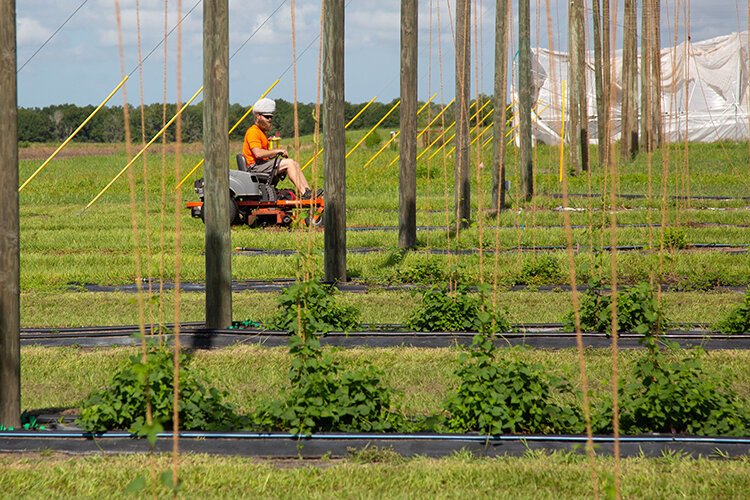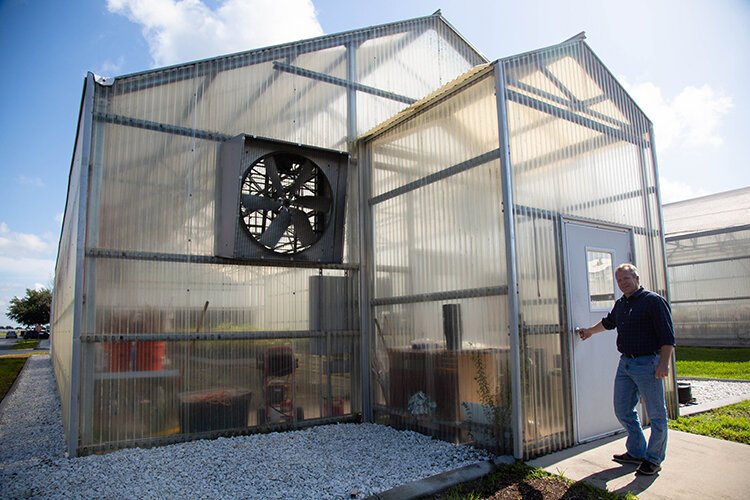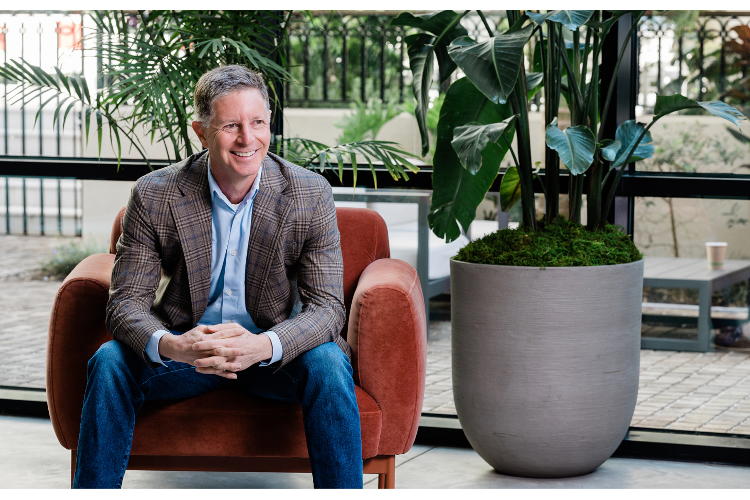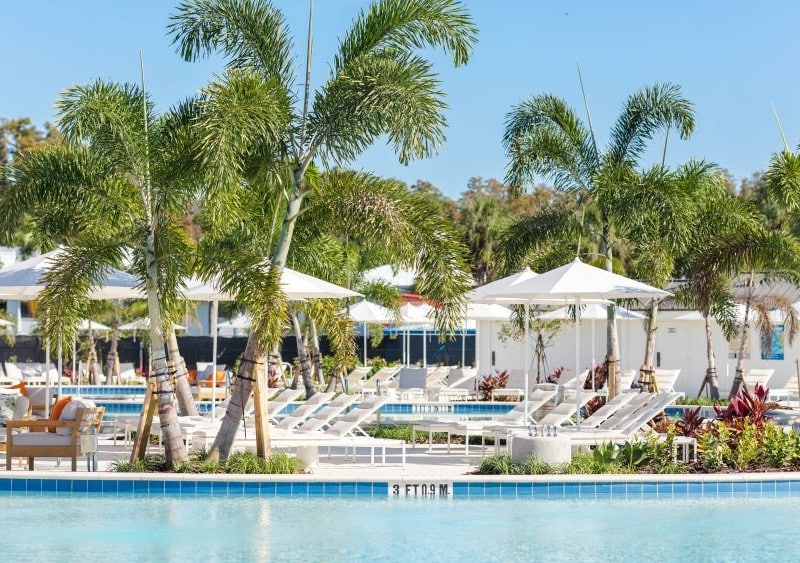Florida ag researchers, farmers experiment, invest in tech for farming solutions
Ag researchers are studying pests, funguses, climate change, and other challenges that farmers face on a daily basis. All of these threaten the economic balance of the farm industry, the financial situation for individual farmers, and the food we all put on our tables every day.
Researchers with the University of Florida Institute of Food and Agricultural Sciences (UF/IFAS) are helping solve long-time problems with new ideas. Consider citrus greening, a disastrous disease first identified in 2005 that is ravaging the state’s citrus industry. Oranges and other citrus crops muster more than $8 billion for Florida annually, but that figure represents a 50% drop from just a few years ago.
Last year, UF was awarded $10.5 million to develop new non-transgenic citrus varieties that resist the greening pathogen. While researchers work around the clock to fight back against greening before the state’s citrus economy experiences a near-total collapse, greening isn’t the only problem for which state agricultural leaders are seeking solutions.
Pests, fungus, and the changing climate are only a few of the challenges that farmers face on a daily basis. All of these threaten the economic balance of the industry and, moreover, the financial situation for individual farmers, many of whom literally bank their properties on the outcome of this year’s crop.
“How do we maintain our agriculture base that we have in Florida?” asks Stephen Gran, Hillsborough County extension director at the UF/IFAS Gulf Coast Research & Education Center in Balm. “One way is by improving the economics of the industry. We do this through increasing efficiency, decreasing environmental impact, and increasing the economic prosperity – that’s the only way to maintain agricultural use in Florida is maintaining profitability.”

More efficient use of land and the growth of more valuable crops has helped make agricultural operations more lucrative for many local farmers. While locally there has been a 9.8% decline in the amount of land used for agricultural purposes, down from 265,000 acres to 239,500 over the past 20 years, there has also been a 74% increase in revenue related to agricultural operations during that timeframe, up from $500 million to $865 million. In many cases, as farmers sell valuable land closer to populated areas, they can turn that money around by investing it into new farmlands implementing better technology and higher-value, higher-yield crops. Farming isn’t cheap.
“Strawberry farmers essentially mortgage the farm each year to do what they do. It’s around $25,000 per acre to plant and prepare a strawberry field,” says Gran. “If there’s a freeze, disease, or a downward adjustment in the market, the farmer is at risk of losing everything.”
The balance between risks and rewards is often divided by a very thin line, and economics drives almost everything in farming.
“Why don’t we see so many local strawberries in December? While they are being picked in December, the price they’re paying in New England is higher than folks are willing to pay here, so that’s where the strawberries will go,” Gran explains. “If we just wanted to feed our local market, we’d need maybe 500 acres of strawberries. But, we have 12,000 acres. So, if we just focused on selling locally, we’d be oversaturated.”
He says if the public wants to see more local crops and more local produce at grocery stores and farmers’ markets, we need to see more local farmers.
Those who wish to get into farming can refer to the UF/IFAS in Balm and similar extension services in other Florida counties for help. Gran and his team at the UF/IFAS Extension serve as a liaison between UF researchers and the community, providing resources for farmers and the rest of the public on the latest techniques and advances in horticulture that can help make raising fruits, vegetables, and even exotic plants more successful, and more economically viable, for growers.
“We’re always trying to find ways to grow crops with minimal input on the environment while providing the best possible profit for the farmer,” Gran remarks. “And this translates to the consumer in that we’re using less water, less fertilizer that runs off into the groundwater and surrounding bodies of water.”
In addition to more environmentally sound farming, Gran says one of the latest objectives on the research side is advancing the use of new types of crops.
“Alternative crops are one of the most important things happening in research right now.”
Many of the former citrus groves that have been devastated by greening are turning into fertile lands for alternative crops, including grapes, blueberries, strawberries, leafy greens, hops, artichokes, and tropical or woody ornamentals and fish – the latter itself a $20 million industry. But raising alternative crops brings new challenges for local farmers who may have little to no experience in growing these plants.
Weeding out challenges
“One issue we identified locally involves growing tropical woody ornamentals, and we’ve been having problems with the weeds,” Gran relates. “There’s a lot of hand labor that goes into getting weeds out of containers, which if you let them go for a month they take over and the plants become unsaleable. A lot of money is spent in getting weeds out of containers. We didn’t have a lot of information on pre-emergent herbicides you could put on top of the pots to minimize weed germination and save a ton of labor pre-emergent herbicides over the crop would save a ton of labor.”
But research is helping to change this. Following a windfall of research grant money, Dr. Chris Marble, an ornamental weed scientist based out of a UF/IFAS Mid-Florida Research & Education Center in Apopka, and his team have conducted research that minimizes economic input and increases profitability. “When you’re growing in a bed, it’s easy to put out plastic, but when you’re growing ornamentals it is harder to put out plastics over pots,” explains Gran.
“Pot-to-pot culture is used when ornamentals are young,” he says, describing a propagation process in which a baby plant, called a liner, is stuck inside a pot and, as that liner grows, reaches other pots and separated to create new individual plants. “But when they’re in a bed you can put four to five across in a bed and you plant them in a row. What we did was put plastic over the top of that and then put our baby plants in there. What we found is it saves tremendous amounts of water and minimizes weeds — hardly any weeds came up. It would be a huge savings for farmers if they adopted this.”
Fighting against weeds is also among Dr. Nathan Boyd’s objectives at the Balm UF/IFAS facility. The associate professor of horticultural services has many ongoing projects at the 490-acre research and education center in Balm, including breeding new varieties of caladium, a popular multicolored exotic plant. But he’s focusing much of his research and development energy into a new device that utilizes artificial intelligence to identify weed species.
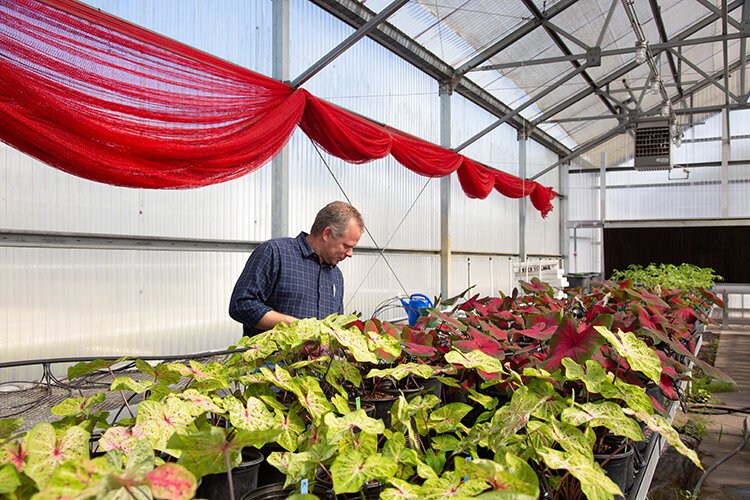
“Basically, we are training a program to recognize weeds, and in the process of training, you get the program to recognize what species the weed is — something we’ve never been able to do in the past — and then be able to tell where it is in space. Then you take the same program and integrate it into an herbicide sprayer,” says Boyd. “Until now, farmers would spray entire fields with herbicides. Now what they’re able to do is as a machine is driving through the field, it can look for weeds and spray that weed.”
The goal is to use less herbicide in the field, saving growers money, cutting down on the amount of herbicide chemicals in the environment, and reducing overspray of these herbicides on plants growers wish to keep.
“We hope not to just attach these machines to tractors, but also attach it to robots — and this can change the entire industry. We’ve been trying for 50 years to do precision agriculture, but limitations in the past were that we didn’t have computer programs that could recognize pictures or species quickly enough.”
He said advancements in processing speeds have really helped improve the feasibility of using weed recognition programs in a more conventional commercial environment.
“I can drive a tractor around a field at four or five miles per hour — typical operating speed — and have a camera three or four feet away from the ground, and it can process the information fast enough to keep up.” The UF/IFAS team benefits from programs that are designed from people around the world who offer them online for free, such as the one Boyd uses that was designed by a graduate student. “And this system is being designed to be purposefully user-friendly. It’s a program that I am able to control through my phone.”
Meanwhile, Hillsborough County Vegetable & Fruits Agent Alicia Whidden says the team at the UF/IFAS Gulf Coast Research & Education Center is moving ahead on technology that uses a special kind of light to solve a problem plaguing strawberry growers.
“They’re working on a machine that uses UV light to help treat powdery mildew on strawberries. So, instead of spraying an herbicide or a fungicide, the light kills the spores before they germinate.” She says UV lighting is also a solution to treating other types of plant problems. “It just blows me away.”
Whidden began working with strawberries back in 1981 when drip irrigation — an efficient watering technique used throughout virtually the entire strawberry industry today — wasn’t used.
“Back then it was overhead sprinklers. Drip [irrigation] involves putting lines under the plastic so the water goes only to the roots of the plant — the water isn’t lost to evaporation. Now they also do fertigation — putting fertilizer in the water.”
She says strawberry growers have been among the first in local agriculture to adopt new technologies.
“Back in the early 1980s, plastic culture was still a very new technology. But going to drip? Daddy didn’t do it that way. So, there was a lag.”
However, a few growers who remain top players in the industry tried it — and it worked.
“Economics drives a lot of the advances. If you want to increase profitability, you’ve got to look ahead.”
Robotics may ensure strawberry fields forever
Looking ahead is what Gary Wishnatzki, owner of Wish Farms in Plant City, is doing. He’s overseeing the research and development of a strawberry-picking robot that could head off massive labor shortfalls throughout the strawberry-growing industry.
“It’s a collaborative effort with other strawberry farmers and is very much a testament to how badly this technology is needed, because of the labor shortages the industry has been experiencing,” says Wishnatzki, who founded Harvest CROO (Computerized Robotic Optimized Obtainer) Robotics in 2013 and is working with robotic engineer Bob Pitzer on a commercially viable automatic strawberry picker.
Wishnatzki says this is not an effort to replace human workers with automation — he and other farmers are happy to pay pickers $12 to $15 per hour or even more. The problem is a shrinking, aging workforce.
“Fewer people are coming to the country who want to pick strawberries,” he says.
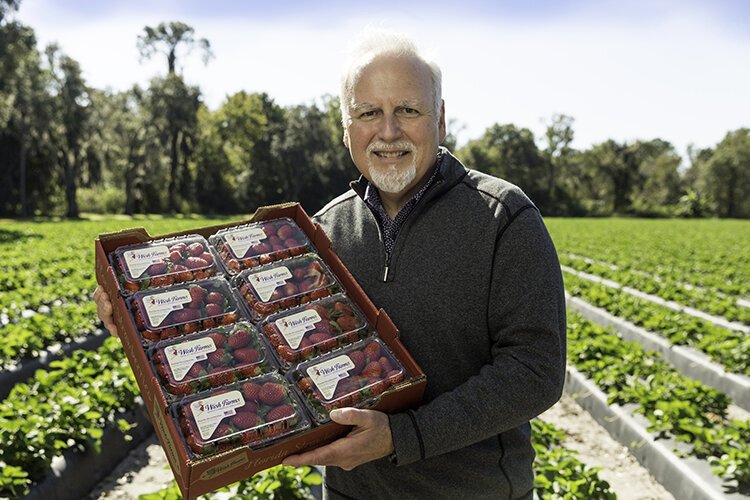
The third-generation operator of Wish Farms, founded in 1922, says the automation endeavors at Harvest CROO Robotics are born out of necessity.
“It’s pretty widely believed that if we’re not successful in solving labor shortages with robotics, we’re heading toward a future with much higher-priced strawberries for consumers because price and availability is going to drive growers out of business. You won’t see the same year-around availability or the same affordability for consumers.”
Some 70% of the players in the U.S. strawberry industry have invested in Harvest CROO Robotics. Many of these investors fear labor shortfalls could push us to a day that strawberries become an expensive luxury item, as they were in the early 1970s when a pound of early-season strawberries sold for as much as $25 in today’s dollars.
Still, despite overall declining numbers of human pickers, the strawberry industry remains ripe for Wishnatzki, who oversees several large croplands in Plant City, Dover, and Duette totaling more than 1,600 acres of strawberries. While the bulk of his operation is in growing strawberries using conventional techniques, he’s also found great success in organic produce, having been the first commercial, large-scale strawberry grower in Florida. And some of the lessons he’s gleaned from perfecting his organic operations have also helped him innovate his conventional growing techniques.
“Organic farming helped us learn some things about pesticides, fertilizer usage, and it’s actually helped us improve some things with our conventional farming practices,” says Wishnatzki. “One of the things we’re doing is using beneficial insects, something we now do on the conventional side that we probably wouldn’t be doing if not for our organic farming. It has saved us money, because we learned some of the time, that we were spending money on pesticides or fungicides that really weren’t giving us any benefit.”
Wish Farms may have built its name on tasty strawberries, but like many other local farmers is finding increased success in alternative crops. Wishnatzki and his team began growing blueberries in the 1990s and now also grows raspberries and blackberries, with operations occurring in all 52 weeks of a year. This keeps the Wish Farms team busy – and profitable. “We’re one of only a very small number of farms that grows strawberries, blueberries, raspberries, and blackberries year-round.”
Tasty alternatives
While Wishnatzki has added new types of crops to his traditional strawberry operations, other local farmers have started their agricultural businesses off on a different foot from the very first step. Strong Tower Vineyard in Spring Hill started sales operations in 2007 with grapes — a crop not usually associated with Central Florida.
“We started planting the first vines in 2001 and planted more every year thereafter,” says owner-operator Terry McKnight, a retired chiropractor who with his wife, Janis, took a crack at the wine industry. The land they work now was once a thoroughbred horse farm and has proven fertile grounds for the vineyards, where red and white grapes are grown to create a variety of craft wines.
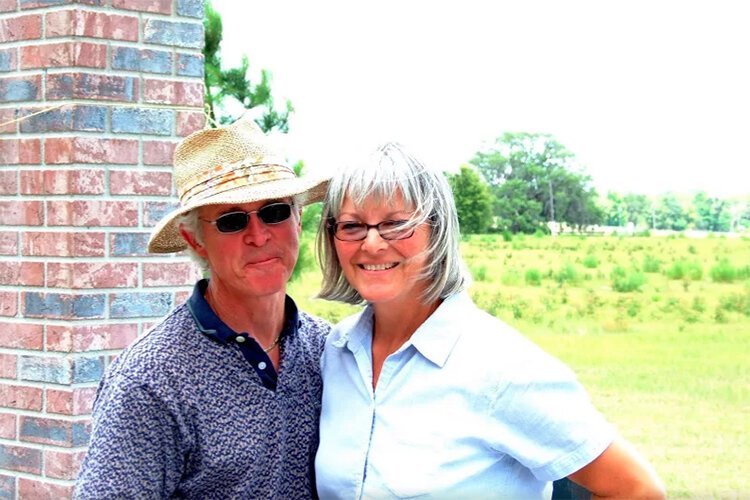
Operating a vineyard in Central Florida doesn’t come without its challenges, but the McKnights have overcome these through making tweaks where necessary and learning through trial and error.
“I’m convinced usually anything can be grown anywhere, within reason, so recognizing our own special elements in Florida, we can and did adjust to accommodate strong growth in this area,” says McKnight. “Most folks think the sun is our greatest obstacle, which it isn’t, provided you have enough water and nutrient to the plants. For example, the sun in California is as intense as ours. Yet everyone recognizes California as a great grape-growing environment, just not with the humidity we have here in Florida, which is really our greatest concern.”
Humidity, he says, can generate molds, mildew, and fungus that damage fruit. But there’s a natural way around that.
“Certain naturally occurring elements and bacteria — as I say, ‘Happy Bugs’ — have been used for years in many wine growing places and can be sprayed on the vines for their benefit,” McKnight says. “In utilizing some of these tools, we can effectively increase the health of the vines and knock back a large part of the humidity issues without negatives. While we are not certified as organic, our methods are very close to that.”
While opportunities for growing other crops may come along down the pike, McKnight says he and Janis are focusing their energies on growing the best vineyards.
“The conditions we have and time available are suited to grapes, which are our only crop. Cycles of the year, earth conditions, pruning season, and chemistry are for our one crop only.”
This niche focus is of great practicality.
“For example, grapes want a fairly neutral soil PH, while blueberries need an acidic PH. Growing the two crops at the same time, in the same location, will result in conflict, and poor plants and poor fruit produced – if any – from both.”
In other words, he says a single focus is best suited for a single fruit. “Every fruit has its own specific personality which needs to be closely plugged into, ensuring the best it has to offer is presented at harvest.”
Even with a singular focus on crop activities, the McKnights offer a diverse array of wines, including several incorporating other locally grown fruits such as blueberries and strawberries.
“For the moment, making wine people can’t live without and having some fun on the way while supporting our local neighborhood and community, is good.”
For more information, visit these links:
- University of Florida Institute of Food and Agricultural Sciences (UF/IFAS)
- UF/IFAS Gulf Coast Research & Education Center in Balm
- Harvest CROO (Computerized Robotic Optimized Obtainer) Robotics
- Strong Tower Vineyard
- Wish Farms


